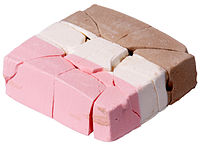
Photo from wikipedia
Abstract This work is aimed at demonstrating the effect of hydrothermal treatment on the mechanical dewatering, thermal drying and stickiness of sewage sludge from two different wastewater treatment plants (SS1… Click to show full abstract
Abstract This work is aimed at demonstrating the effect of hydrothermal treatment on the mechanical dewatering, thermal drying and stickiness of sewage sludge from two different wastewater treatment plants (SS1 and SS2). The analysis of particle size, microstructure and volatile matter content of sludge was conducted to explore the influencing mechanism of hydrothermal treatment. The impact and significance of three factors, i.e. hydrothermal temperature (130–220 °C), retention time (30–75 min) and calcium oxide content (0–5 wt.%), were studied by an orthogonal method. Range and variable analysis were carried out to investigate the significance of the factors. The results indicated that sludge particle size showed a 10–25% reduction after hydrothermal treatment, indicating a degradation of EPS and bacterial cells, which was also confirmed by microstructural analysis. Sludge dewatering performance was markedly promoted by increasing hydrothermal temperature, intention time or CaO content. But CaO showed 1.8–7.8 times higher significance than that of hydrothermal temperature and intention time. On the other hand, both hydrothermal temperature and retention time showed 2–5 times higher significance on chemical oxygen demand of filtrate and drying rate of dewatered sludge cakes than that of CaO. Increasing hydrothermal temperature or retention time led to the increase of the chemical oxygen demand and the decrease of the drying rate in general. Sludge decomposition was also manifested by the change of its volatile matter content which showed a strong positive correlation with the water content of dewatered sludge cakes and a negative correlation with the adhesive and cohesive stress of dewatered sludge cakes. Finally, the economic efficiency of hydrothermal treated sludge dewatering and thermal drying system was calculated and compared with that of conventional direct thermal drying. The total energy consumption of the system is about 25–40% lower than conventional drying for both of sludge, and the operation cost of the system is about 17–30% lower than that of the conventional drying.
Journal Title: Journal of Cleaner Production
Year Published: 2019
Link to full text (if available)
Share on Social Media: Sign Up to like & get
recommendations!